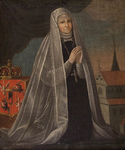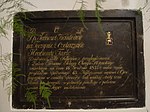Topór coat of arms
| Topór | |
|---|---|
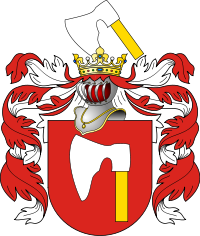 | |
| Battle cry | Szarża |
| Alternative name(s) | Bipenna, Bipennis, Szarża, Wścieklica |
| Earliest mention | 1282 (seal), 1401 (record) |
| Families | show 640 names |
| Cities | Opole Lubelskie, Rymanów, Stawiski, Chyrów, Toporów |
| Divisions | Gmina Klimontów, Gmina Końskowola, Gmina Zaklików (former city), Gmina Żegocina |
Topór (Polish for "axe") is a Polish coat of arms. It was used by several szlachta (noble) families in medieval Poland and under the Polish–Lithuanian Commonwealth.[1]
History[]
The topór coat of arms is said[according to whom?] to be one of the oldest Polish szlachta emblems, if not the oldest. Its use dates back to at least as far as a seal of the late 13th century. Before the Union of Horodło (1413) approximately 220 Polish szlachta families - mostly in and around Kraków, Lublin and Sandomierz - used this symbol.
Under the Union the coat of arms was represented by , the Voivod of Kraków, and by , a Lithuanian boyar who represented Lithuanian noble families. After the union another 150 families in Lithuania adopted the topór coat of arms. Due to its antiquity it was sometimes referred to as "Starża", an Old-Polish word denoting great age.
Blazon[]
Gules, axe argent. The crest is in the form of an axe embedded in the helm, argent.
In Latin: (Topor). Thopor siue Bipennis alba in campo rubeo (...)[2]
Notable bearers[]
Notable bearers of this coat of arms have included:
- Jan Jerzy Grabowski
- Cyprian Norwid
- House of Ossoliński
- [3]
- House of Tęczyński
- House of Tarło
- Eustachy Trepka
- Józef Zabiełło
- Family of Zemła and Zemło ennobled 1413 in the Union of Horodło for taking part and courageous fighting in the battle of Grunwald 1410.
-
Gallery[]
Aristocratic variations

Princely House of Ossoliński (1633)

Counts (1824)

Counts Grabowski (1816)
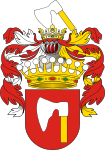
Counts (1781)

Counts Ossoliński (1785) and Counts Tęczyński (1561)

Counts (c. 1683)

Coat of arms of baron (1808)
Standard variations

Ennoblement of (1531) (noted by J.K. Ostrowskiego)

Coat of arms of family (18th century)

Ennoblement of (1790)

Ennoblement of Michał, Kazimierz and Felicjan Jakubowski (1764)

Coat of arms of the family (Morawitzky) (Silesia, 17th century)

Coat of arms of the family from Paczynin Silesia (16th century)
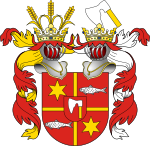
Variation of the coat of arms of (adopted by ) (noted by J.K. Ostrowskiego)
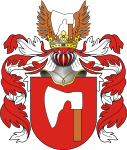
Ennoblement of (1569) (wrongly ascribed by Chrząński as the coat of arms of the Tarło family)

Topór II – variant

Topór III – variant

Topór IV – variant
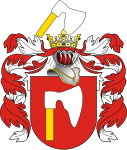
Topór V – variant
Coat of arms of cities and gminas

Coat of arms of Krajenki

Coat of arms of Opole Lubelskie

Coat of arms of

Coat of arms of

Prewar coat of arms of Chyrowa

Prewar coat of arms of Toporów

Coat of arms of Gmina Klimontów (former city)

Coat of arms of Gmina Końskowola (former city)
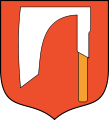
Coat of arms of the former city of Zaklikow

Prewar coat of arms of
Coat of arms with the topór symbol

Coat of arms of Krzeszowice
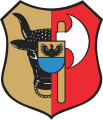
Coat of arms of Leszno

Coat of arms of Wągrowiec

Coat of arms of Powiat Wągrowiec
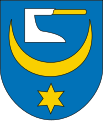
Coat of arms of Żabno

Prewar coat of arms of Mosty Wielkie

Coat of arms of former Gmina Białołęka

Coat of arms of Gmina Białośliwie

Coat of arms of Gmina Liszki

Coat of arms of Gmina Łańcut
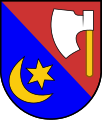
Coat of arms of Gmina Mielec
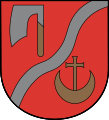
Coat of arms of Gmina Mircze
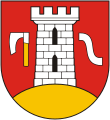
Coat of arms of Gmina Nawojowa

Coat of arms of Gmina Sterdyń

Coat of arms of Gmina Tarłów

Coat of arms of Gmina Wilczyce

Coat of arms of Gmina Zabrodzie

Coat of arms of Gmina Zębowice

Coat of arms of Gmina Limanowa

Coat of arms of Gmina Nowe Brzesko
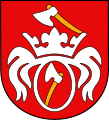
Coat of arms of Gmina Trzcinica
Paintings with the coat of arms topór

Portrait of Jerzy Ossoliński with coat of arms in upper left

Portrait of Franciszek Maksymilian Ossolinski with coat of arms on the shield (right bottom corner)

Portrait of Jan Zbigniew Ossolinski with coat of arms in upper right
Jan Magnus Tęczyński with coat of arms in upper right
Topór on the painting of Elizabeth Granowska, 1779
Other
The epitaph of (1790-1855) in Szczaworyż, Church of St. James
Coat of arms of the Ossoliński family on the St. Antoni Padewski Church in Warsaw

The ruins of Krzyżtopór Castle in Ujazd (topór coat of arms on the right side of the gate)
See also[]
- Polish heraldry
- Heraldic family
- List of Polish nobility coats of arms
External links[]
- J. Lyčkoŭski. "Belarusian Nobility Coats of Arms". (in English)
- "Armorial of Belarusian Nobility". (in English)
Bibliography[]
- Kasper Niesiecki: Herbarz polski. T. 9. 1839-1846
- Franciszek Piekosiński: Heraldyka polska wieków średnich. Kraków: Akademia Umiejętności, 1899
- Józef Szymański: Herbarz średniowiecznego rycerstwa polskiego. Warszawa: PWN, 1993
- Bartosz Paprocki, Jan Kazimierz Turowski: Herby rycerstwa polskiego przez Bartosza Paprockiego zebrane i wydane r. p. 1584. Kraków: Wydawnictwo Biblioteki Polskiej, 1858.
- Stanisław Teodor Chrząński: Tablice odmian herbowych. Juliusz Karol Ostrowski, 1909, s. V.
- Tadeusz Gajl: Herbarz polski od średniowiecza do XX wieku : ponad 4500 herbów szlacheckich 37 tysięcy nazwisk 55 tysięcy rodów. L&L, 2007, s. 363. ISBN 978-83-60597-10-1.
- Barbara Trelińska: Album armorum nobilium Regni Poloniae XV - XVIII saec. Herby nobilitacji i indygenatów XV - XVIII w.. Lublin: 2001,
- Stanisław Dziadulewicz: Herbarz rodzin tatarskich w Polsce. Wilno: Stanisław Dziadulewicz, 1929
References[]
- ^ Alfred Znamierowski: Herbarz rodowy. Warszawa: Świat Książki, 2004, s. 171. ISBN 83-7391-166-9.
- ^ Jan Długosz: Insignia seu clenodia incliti Regni Poloniae
- ^ "Genealogia Polska 1 Polish Genealogy: Szołajski". 2017.
- Polish coats of arms






















































